Analysis: US company Radia’s Windrunner to become world’s largest transport aircraft with 7,702 m³ capacity

{loadposition bannertop}
{loadposition sidebarpub}
During an interview with Aerospace Global News on August 27, 2024, Mark Lundstrom, CEO and founder of the Colorado-based aerospace company Radia, disclosed a dual-use capability for the Windrunner, the world’s largest transport aircraft currently in development. Originally designed to transport oversized wind turbine blades, the 108-meter-long aircraft is now being considered for additional applications, including possible military transport, including up to six F-16 fighter jets or six Chinook helicopters with their rotors still attached.Follow Army Recognition on Google News at this link
Originally designed to transport oversized wind turbine blades, the 108-meter-long aircraft is now being considered for additional applications, including possible military transport of up to six Chinook helicopters with their rotors still attached. (Picture source: Radia)
Powered by four fuel-efficient engines, Radia’s WindRunner is designed to reach cruise speeds of up to Mach 0.6 (approximately 740 km/h) while carrying payloads of up to 72,575 kg. The aircraft will be primarily used to install Radia’s GigaWind onshore turbines, which have blades over 100 meters in length and are intended to increase energy output while reducing the overall cost of wind power. Radia has conducted extensive testing and simulations to validate the WindRunner’s design, including wind tunnel testing of scale models to optimize aerodynamic performance and ensure structural integrity.
As production progresses, Radia is working with aerospace manufacturers and suppliers to develop the WindRunner using modern materials, manufacturing techniques, and avionics. With the design finalized and preparations for production underway, Radia plans to begin commercial operations by the end of 2027, with an initial contract to deliver turbines to a gigawatt-scale wind farm.
When compared to other large transport aircraft, the Windrunner project offers a payload bay capacity of 7,702 cubic meters. This is significantly larger than the Antonov An-225 Mriya, with a capacity of 1,300 cubic meters, the Antonov An-124, with 1,160 cubic meters, and the Boeing 747-400, with 610 cubic meters. Lundstrom noted that the Windrunner is designed to prioritize moving cargo based on volume rather than mass, a novel approach that differentiates it from other aircraft in the current market for heavy-lift transport.
The Windrunner aircraft will offer a cargo volume approximately 12 times larger than that of a Boeing 747-400 and nine times that of the largest remaining Antonov aircraft, the An-124. (Picture source: Radia)
Therefore, the aircraft offers a cargo volume approximately 12 times larger than that of a Boeing 747 and nine times that of the largest remaining Antonov aircraft, following the destruction of the sole An-225 Mriya on February 24, 2022, during the Ukrainian Battle of Antonov Airport. While its weight capacity is around 70 tons, the Windrunner can accommodate cargo up to 105 meters in length, such as wind turbine blades. Lundstrom suggested that the size and capacity of the aircraft could be suited for other types of cargo as well, including potential military equipment, citing a shortage in the production of large cargo aircraft both in the military and commercial sectors.
The consideration of military use for the Windrunner comes amid a backdrop where production of other large transport aircraft has ceased. The Lockheed C-5 Galaxy and the Boeing C-17 Globemaster III have been out of production since 1989 and 2013, respectively, while the availability of the Antonov An-124, the largest military transport aircraft currently in service, has been limited due to the ongoing conflict between Russia and Ukraine. Lundstrom indicated that the Windrunner is being developed with the capability to fulfill both civilian and military roles, and that discussions with potential military end-users are in progress.
Like the defunct and regretted Antonov An-225 Mriya, the Windrunner’s design includes a front-loading cargo hold capable of accommodating a range of military assets, including up to six F-16 fighter jets or six Chinook helicopters with their rotors still attached. Historically, transporting F-16s by air has required the removal of wings and tail sections, whether by the U.S. Air Force using the C-5 Galaxy, the Royal Norwegian Air Force utilizing the An-124, or the transport of four Israeli F-16s inside the An-225 Mriya in 2021. The Windrunner’s cargo bay dimensions, sufficient to fit the F-16’s 10-meter wingspan and 5.1-meter height, present an option that avoids disassembly, which could potentially reduce time and logistical costs associated with transporting military aircraft.
The Windrunner transport aircraft will be primarily used to install Radia’s GigaWind onshore turbines, which have blades over 100 meters in length and are intended to increase energy output while reducing the overall cost of wind power. (Picture sources: Radia)
Transporting military assets by air instead of conducting a ferry flight offers various potential benefits. It could reduce operational costs, including the elimination of air-to-air refueling requirements, and decrease personnel hours needed for both flight crews and maintenance teams. Radia’s design, which allows transported assets to remain intact, also avoids the need for disassembly and reassembly at the destination, potentially improving operational efficiency.
Lundstrom stated that the Windrunner aircraft could transport six Chinook helicopters with their rotors still on, due to its ability to function on a variety of airfields, including those with unpaved surfaces and dirt airstrips. The Windrunner is designed to operate from runways as short as 1,800 meters, which is shorter than that required by many other large aircraft, and can operate on surfaces that do not need to be reinforced concrete. The placement of the engines high above the ground reduces the risk of foreign object damage, a consideration when landing on less developed airfields. Additionally, with a wingspan slightly less than the Airbus A380, the Windrunner could use existing airport infrastructure and hangar space.
The aircraft’s development will continue to be monitored closely, as the Windrunner, at 108 meters in length, 24 meters in height, and with an 80-meter wingspan, has larger overall dimensions compared to several existing heavy military transport aircraft, such as the Antonov An-124, which is 69 meters long with a 73.3-meter wingspan, and the Lockheed C-5 Galaxy, which measures 75 meters in length and has a wingspan of 67.9 meters. The Antonov An-225, which was the largest aircraft before its destruction, was shorter than the Windrunner at 84 meters long but had a slightly greater wingspan of 88.4 meters.
Powered by four fuel-efficient engines, Radia’s WindRunner is designed to reach cruise speeds of up to Mach 0.6 (approximately 740 km/h) while carrying payloads of up to 72,575 kg. (Picture source: Radia)
The Windrunner is also longer and wider than smaller transport aircraft like the Airbus A330 MRTT (59 meters in length, 60 meters wingspan) and the Xi’an Y-20 (47 meters in length, 50 meters wingspan), indicating its capacity to carry larger cargo items. In terms of payload capacity, the Windrunner’s maximum payload weight of 72,575 kilograms is less than the Antonov An-225, which could carry up to 247,000 kilograms, and the Antonov An-124, which has a payload capacity of 150,000 kilograms. The Lockheed C-5 Galaxy also exceeds the Windrunner in this regard, with a maximum payload capacity of 129,274 kilograms.
However, the Windrunner carries more than the Ilyushin Il-76, which has a maximum payload of 60,000 kilograms, and the Embraer C-390, which carries up to 26,000 kilograms. Aircraft like the Boeing C-17 Globemaster III, with a payload capacity of 77,500 kilograms, are closer in range to the Windrunner. The Windrunner’s cargo bay volume of 7,702 cubic meters is higher than that of the Antonov An-22, Airbus A400M, and Kawasaki C-2, which carry 80,000 kilograms, 37,000 kilograms, and 36,000 kilograms, respectively, but have smaller internal cargo dimensions.
With the capacity to transport six F-16s at a time, just four Windrunners could move an entire squadron to a forward base… or accelerate the delivery of fighter jets to Ukraine. (Picture source: Radia)
Regarding runway requirements, the Windrunner needs a minimum runway length of 1,800 meters, which is shorter than the Antonov An-124, requiring around 2,500 meters, and the Antonov An-225, which needs approximately 3,500 meters for takeoff. This requirement is also less than those of the Lockheed C-5 Galaxy and Boeing C-17, which typically need around 2,300 meters or more depending on the payload and conditions. However, the Windrunner’s maximum range with a full payload is 2,000 kilometers, which is less than other transport aircraft like the Airbus A330 MRTT, with a range of 14,816 kilometers without a payload, and the Kawasaki C-2, with a range of 7,600 kilometers with a partial payload. The Airbus A400M and Xi’an Y-20 also have longer ranges of 4,500 kilometers and 7,800 kilometers, respectively. These comparisons suggest that the Windrunner is positioned to serve specific needs, particularly where transporting large, low-density cargo over shorter distances and operating from shorter runways is required.
Like the defunct Antonov An-225 Mriya, the Windrunner’s design includes a front-loading cargo hold capable of accommodating a range of military assets, including up to six F-16 fighter jets or six Chinook helicopters with their rotors still attached. (Picture source: Planespotters.net/Mehrad Watson)

{loadposition bannertop}
{loadposition sidebarpub}
During an interview with Aerospace Global News on August 27, 2024, Mark Lundstrom, CEO and founder of the Colorado-based aerospace company Radia, disclosed a dual-use capability for the Windrunner, the world’s largest transport aircraft currently in development. Originally designed to transport oversized wind turbine blades, the 108-meter-long aircraft is now being considered for additional applications, including possible military transport, including up to six F-16 fighter jets or six Chinook helicopters with their rotors still attached.
Follow Army Recognition on Google News at this link
Originally designed to transport oversized wind turbine blades, the 108-meter-long aircraft is now being considered for additional applications, including possible military transport of up to six Chinook helicopters with their rotors still attached. (Picture source: Radia)
Powered by four fuel-efficient engines, Radia’s WindRunner is designed to reach cruise speeds of up to Mach 0.6 (approximately 740 km/h) while carrying payloads of up to 72,575 kg. The aircraft will be primarily used to install Radia’s GigaWind onshore turbines, which have blades over 100 meters in length and are intended to increase energy output while reducing the overall cost of wind power. Radia has conducted extensive testing and simulations to validate the WindRunner’s design, including wind tunnel testing of scale models to optimize aerodynamic performance and ensure structural integrity.
As production progresses, Radia is working with aerospace manufacturers and suppliers to develop the WindRunner using modern materials, manufacturing techniques, and avionics. With the design finalized and preparations for production underway, Radia plans to begin commercial operations by the end of 2027, with an initial contract to deliver turbines to a gigawatt-scale wind farm.
When compared to other large transport aircraft, the Windrunner project offers a payload bay capacity of 7,702 cubic meters. This is significantly larger than the Antonov An-225 Mriya, with a capacity of 1,300 cubic meters, the Antonov An-124, with 1,160 cubic meters, and the Boeing 747-400, with 610 cubic meters. Lundstrom noted that the Windrunner is designed to prioritize moving cargo based on volume rather than mass, a novel approach that differentiates it from other aircraft in the current market for heavy-lift transport.
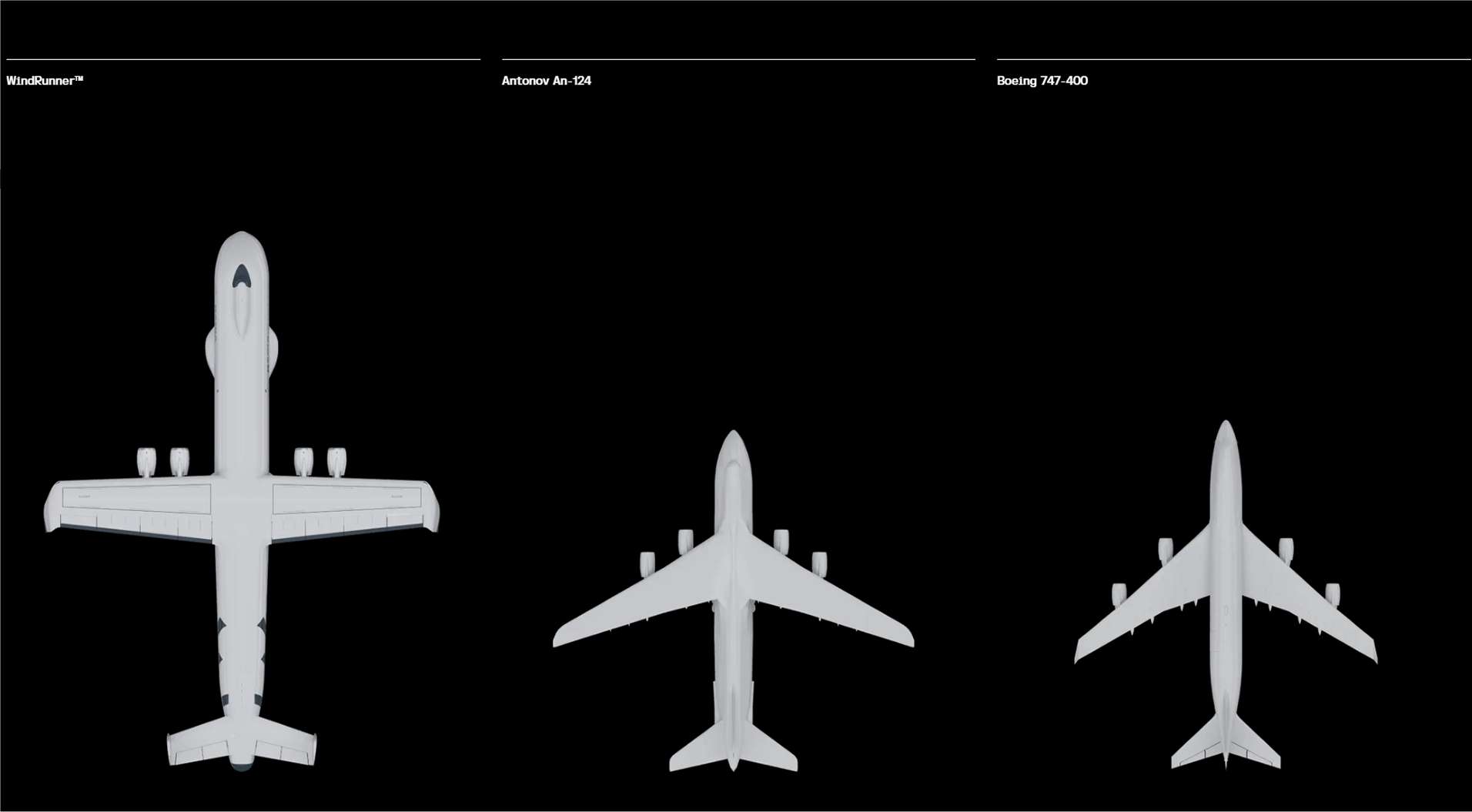
The Windrunner aircraft will offer a cargo volume approximately 12 times larger than that of a Boeing 747-400 and nine times that of the largest remaining Antonov aircraft, the An-124. (Picture source: Radia)
Therefore, the aircraft offers a cargo volume approximately 12 times larger than that of a Boeing 747 and nine times that of the largest remaining Antonov aircraft, following the destruction of the sole An-225 Mriya on February 24, 2022, during the Ukrainian Battle of Antonov Airport. While its weight capacity is around 70 tons, the Windrunner can accommodate cargo up to 105 meters in length, such as wind turbine blades. Lundstrom suggested that the size and capacity of the aircraft could be suited for other types of cargo as well, including potential military equipment, citing a shortage in the production of large cargo aircraft both in the military and commercial sectors.
The consideration of military use for the Windrunner comes amid a backdrop where production of other large transport aircraft has ceased. The Lockheed C-5 Galaxy and the Boeing C-17 Globemaster III have been out of production since 1989 and 2013, respectively, while the availability of the Antonov An-124, the largest military transport aircraft currently in service, has been limited due to the ongoing conflict between Russia and Ukraine. Lundstrom indicated that the Windrunner is being developed with the capability to fulfill both civilian and military roles, and that discussions with potential military end-users are in progress.
Like the defunct and regretted Antonov An-225 Mriya, the Windrunner’s design includes a front-loading cargo hold capable of accommodating a range of military assets, including up to six F-16 fighter jets or six Chinook helicopters with their rotors still attached. Historically, transporting F-16s by air has required the removal of wings and tail sections, whether by the U.S. Air Force using the C-5 Galaxy, the Royal Norwegian Air Force utilizing the An-124, or the transport of four Israeli F-16s inside the An-225 Mriya in 2021. The Windrunner’s cargo bay dimensions, sufficient to fit the F-16’s 10-meter wingspan and 5.1-meter height, present an option that avoids disassembly, which could potentially reduce time and logistical costs associated with transporting military aircraft.

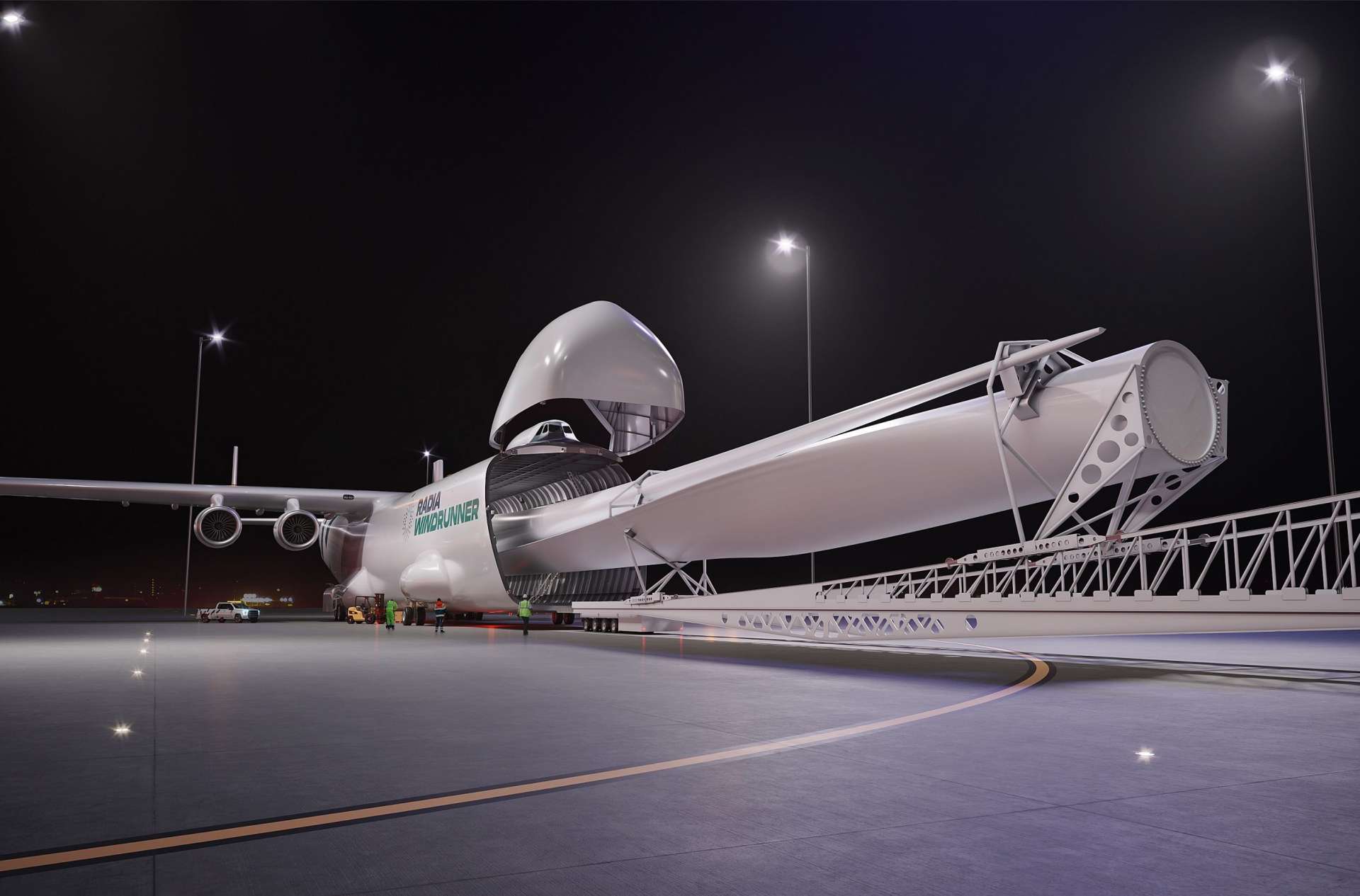
The Windrunner transport aircraft will be primarily used to install Radia’s GigaWind onshore turbines, which have blades over 100 meters in length and are intended to increase energy output while reducing the overall cost of wind power. (Picture sources: Radia)
Transporting military assets by air instead of conducting a ferry flight offers various potential benefits. It could reduce operational costs, including the elimination of air-to-air refueling requirements, and decrease personnel hours needed for both flight crews and maintenance teams. Radia’s design, which allows transported assets to remain intact, also avoids the need for disassembly and reassembly at the destination, potentially improving operational efficiency.
Lundstrom stated that the Windrunner aircraft could transport six Chinook helicopters with their rotors still on, due to its ability to function on a variety of airfields, including those with unpaved surfaces and dirt airstrips. The Windrunner is designed to operate from runways as short as 1,800 meters, which is shorter than that required by many other large aircraft, and can operate on surfaces that do not need to be reinforced concrete. The placement of the engines high above the ground reduces the risk of foreign object damage, a consideration when landing on less developed airfields. Additionally, with a wingspan slightly less than the Airbus A380, the Windrunner could use existing airport infrastructure and hangar space.
The aircraft’s development will continue to be monitored closely, as the Windrunner, at 108 meters in length, 24 meters in height, and with an 80-meter wingspan, has larger overall dimensions compared to several existing heavy military transport aircraft, such as the Antonov An-124, which is 69 meters long with a 73.3-meter wingspan, and the Lockheed C-5 Galaxy, which measures 75 meters in length and has a wingspan of 67.9 meters. The Antonov An-225, which was the largest aircraft before its destruction, was shorter than the Windrunner at 84 meters long but had a slightly greater wingspan of 88.4 meters.
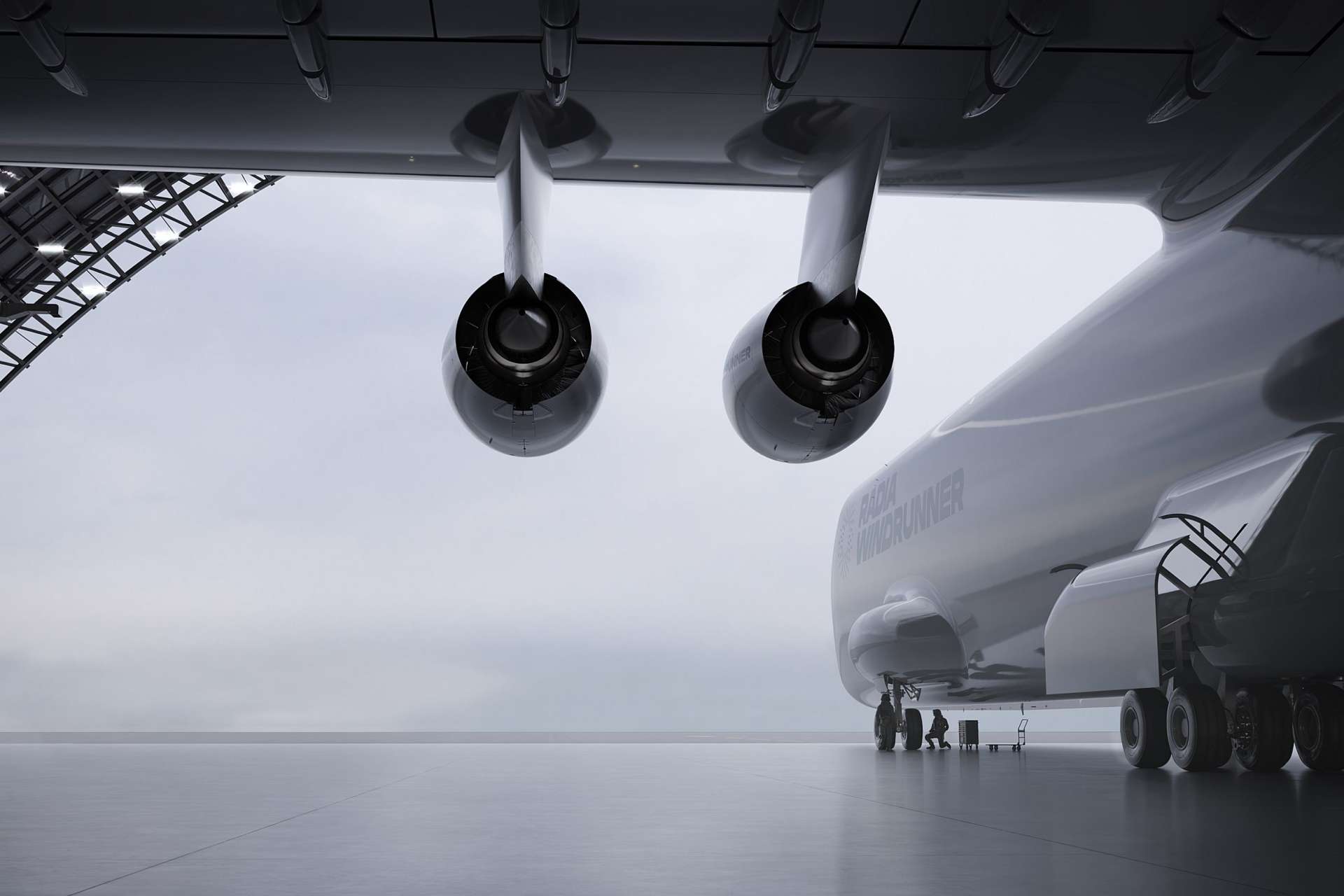
Powered by four fuel-efficient engines, Radia’s WindRunner is designed to reach cruise speeds of up to Mach 0.6 (approximately 740 km/h) while carrying payloads of up to 72,575 kg. (Picture source: Radia)
The Windrunner is also longer and wider than smaller transport aircraft like the Airbus A330 MRTT (59 meters in length, 60 meters wingspan) and the Xi’an Y-20 (47 meters in length, 50 meters wingspan), indicating its capacity to carry larger cargo items. In terms of payload capacity, the Windrunner’s maximum payload weight of 72,575 kilograms is less than the Antonov An-225, which could carry up to 247,000 kilograms, and the Antonov An-124, which has a payload capacity of 150,000 kilograms. The Lockheed C-5 Galaxy also exceeds the Windrunner in this regard, with a maximum payload capacity of 129,274 kilograms.
However, the Windrunner carries more than the Ilyushin Il-76, which has a maximum payload of 60,000 kilograms, and the Embraer C-390, which carries up to 26,000 kilograms. Aircraft like the Boeing C-17 Globemaster III, with a payload capacity of 77,500 kilograms, are closer in range to the Windrunner. The Windrunner’s cargo bay volume of 7,702 cubic meters is higher than that of the Antonov An-22, Airbus A400M, and Kawasaki C-2, which carry 80,000 kilograms, 37,000 kilograms, and 36,000 kilograms, respectively, but have smaller internal cargo dimensions.
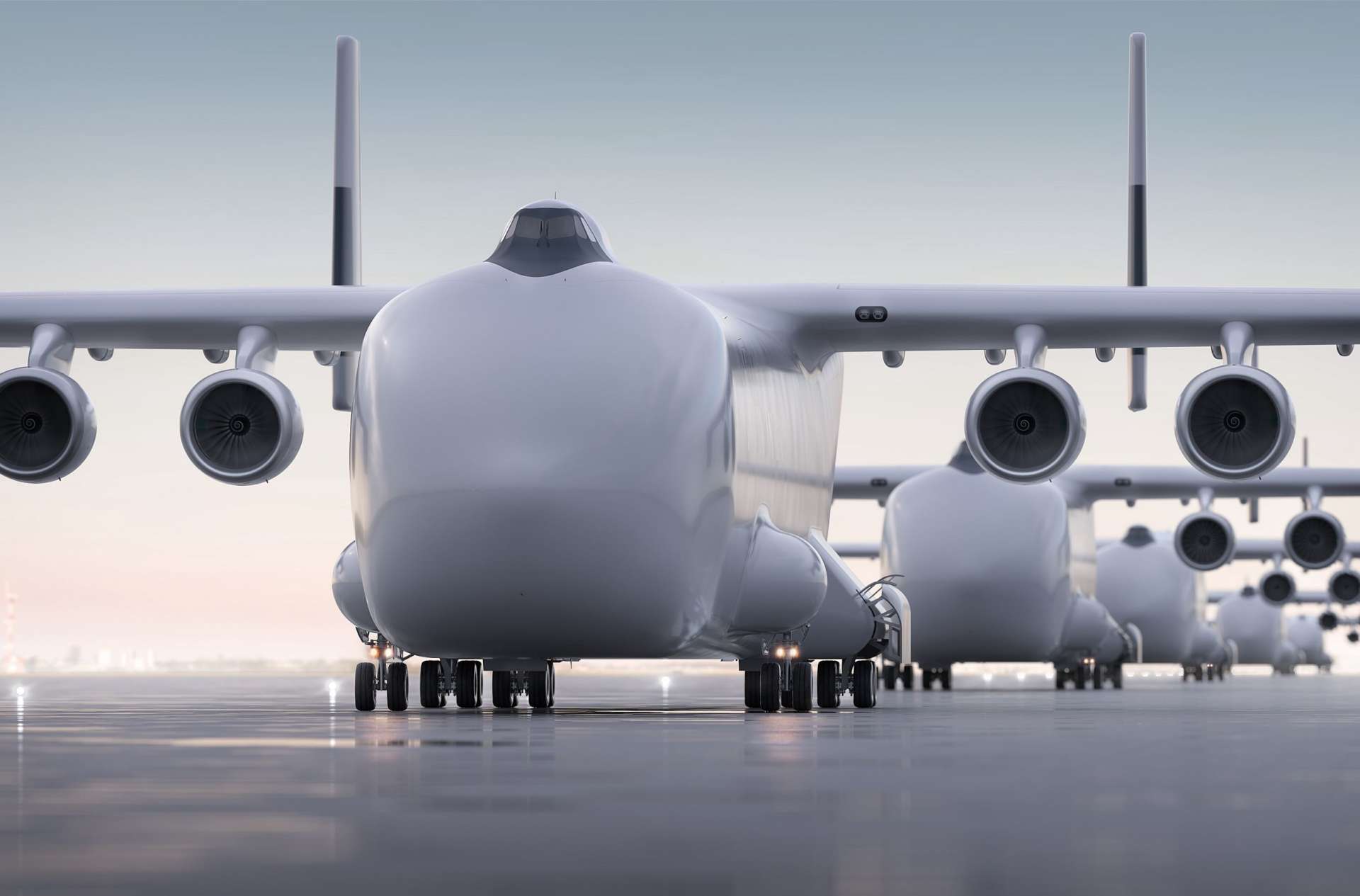
With the capacity to transport six F-16s at a time, just four Windrunners could move an entire squadron to a forward base… or accelerate the delivery of fighter jets to Ukraine. (Picture source: Radia)
Regarding runway requirements, the Windrunner needs a minimum runway length of 1,800 meters, which is shorter than the Antonov An-124, requiring around 2,500 meters, and the Antonov An-225, which needs approximately 3,500 meters for takeoff. This requirement is also less than those of the Lockheed C-5 Galaxy and Boeing C-17, which typically need around 2,300 meters or more depending on the payload and conditions. However, the Windrunner’s maximum range with a full payload is 2,000 kilometers, which is less than other transport aircraft like the Airbus A330 MRTT, with a range of 14,816 kilometers without a payload, and the Kawasaki C-2, with a range of 7,600 kilometers with a partial payload. The Airbus A400M and Xi’an Y-20 also have longer ranges of 4,500 kilometers and 7,800 kilometers, respectively. These comparisons suggest that the Windrunner is positioned to serve specific needs, particularly where transporting large, low-density cargo over shorter distances and operating from shorter runways is required.
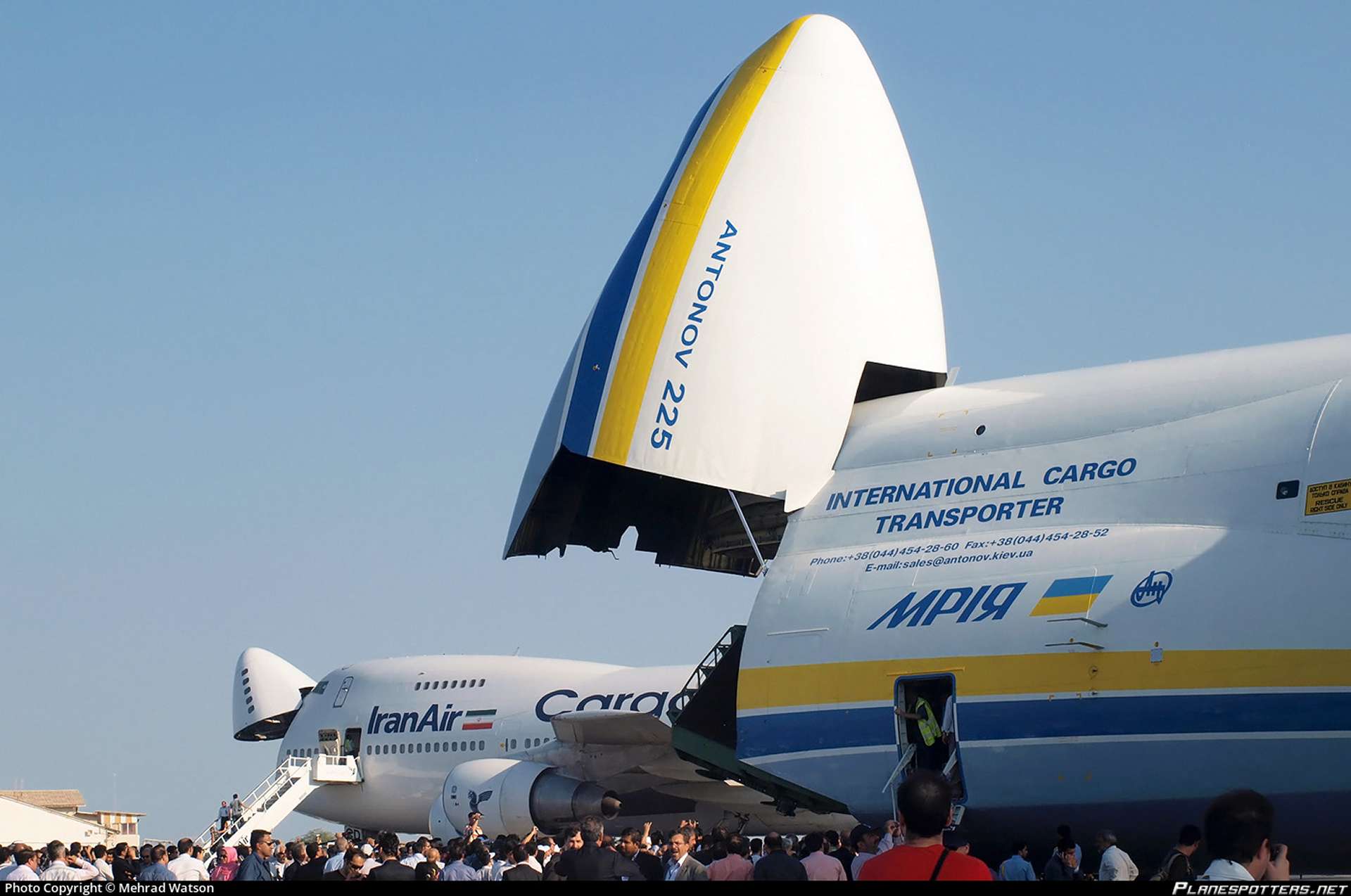
Like the defunct Antonov An-225 Mriya, the Windrunner’s design includes a front-loading cargo hold capable of accommodating a range of military assets, including up to six F-16 fighter jets or six Chinook helicopters with their rotors still attached. (Picture source: Planespotters.net/Mehrad Watson)




